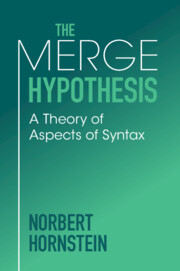Book contents
- The Merge Hypothesis
- The Merge Hypothesis
- Copyright page
- Contents
- Preface
- Abbreviations
- Introduction
- 1 A Whig History of Generative Grammar
- 2 Tools and Particulars
- 3 Adding Labels
- 4 Construal and the Extended Merge Hypothesis (1)
- 5 Construal and the Extended Merge Hypothesis (2)
- 6 A Partial Wrap-Up and Segue
- 7 Labels
- 8 Odds and Ends
- 9 Conclusion
- Bibliography
- Index
9 - Conclusion
Published online by Cambridge University Press: 15 February 2024
- The Merge Hypothesis
- The Merge Hypothesis
- Copyright page
- Contents
- Preface
- Abbreviations
- Introduction
- 1 A Whig History of Generative Grammar
- 2 Tools and Particulars
- 3 Adding Labels
- 4 Construal and the Extended Merge Hypothesis (1)
- 5 Construal and the Extended Merge Hypothesis (2)
- 6 A Partial Wrap-Up and Segue
- 7 Labels
- 8 Odds and Ends
- 9 Conclusion
- Bibliography
- Index
Summary
This chapter rounds off the book by recapitulating the argument that the research program of modern Generative Grammar has provided profound insights into the structure of the faculty of language (FL) to explain both linguistic creativity and linguistic flexibility. The proposal is that the Generative enterprise has allowed us to examine what kinds of recursive procedures natural language grammars contain, and to understand key aspects of the fine structure of FL. The Minimalist Program then asks the obvious next question of why FL has the particular structure Generativists discovered it to have. It is argued that the central Minimalist thesis, the Merge Hypothesis (MH), explains how linguistic creativity is the product of a very simple combinatoric operation (i.e. Merge), and then showed how the MH can be extended (into the EMH) by the addition of labels to cover most of the generalizations discovered in the past sixty years of Generative research.
- Type
- Chapter
- Information
- The Merge HypothesisA Theory of Aspects of Syntax, pp. 230 - 233Publisher: Cambridge University PressPrint publication year: 2024



